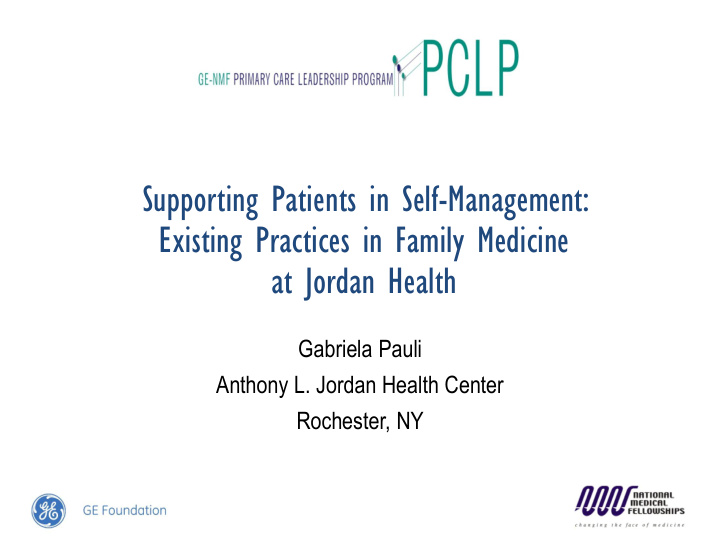



Supporting Patients in Self-Management: Existing Practices in Family Medicine at Jordan Health Gabriela Pauli Anthony L. Jordan Health Center Rochester, NY
Introduction • Chronic conditions are ubiquitous • Patients’ everyday behaviors affect their health conditions patients “self - manage” their conditions • No protocol for providing self-management support within delivery of care model • Not all staff receives training in self-management support • Objective : • How familiar are Jordan providers with self-management support models? • Confident in their knowledge & abilities? How often do providers employ these techniques?
Background • Identified existing Self-management models • Literature review for efficacy of models • Brainstorm with faculty advisor, site supervisor – which models already taught at Jordan? • Selected 8 models: • 5 A’s Behavioral Change Model (Assess, Advise, Agree, Assist, Arrange) • Motivational Interviewing • Teach-back • Ask-tell-ask • Patient Activation • Action-planning forms • Goal Setting • Goal Setting with Confidence-Scaling
Methodology • Web-based survey emailed to all Family Medicine providers, nurses (74 staff members) • 23 participants recruited (31% response rate) • Measured: • Have you received any training in providing SM support ? • Trained in specific model ? • How confident do you feel in your skills utilizing that model? • In what proportion of visits do you use model? • Open-ended: • What works? • What are the barriers?
Results Percent of Respondents with SM training, Staff members with by provider type SM training (N=22) 100% 90% Some 80% training No 70% 41% training 59% 60% 50% 40% 30% 20% 10% 0% LPN or RN MD/DO, NP, or PA
Results 80% 70% 60% % of Respondents with 50% Training in specific method 40% 30% Staff's confidence utilizing 20% method 10% % of visits in which method is 0% utilized N=14 • 7 MD/DO, PA, NP • 7 LPN, RN
Results • Salient themes to open-ended questions • What did staff members identify that works? • Patients identifying their own goals • Creating action-plans • Patients willing, ready to change behaviors (Patient activation!) • What are the barriers? • Not enough time (stated by over ½ of participants) • Many patients lack resources, such as finances, support at home, housing security to make these health behavior changes
Discussion • For nearly all models, staff members’ confidence level was higher than percentage of visits they employ SM model • Look for SM literature specific to underserved populations or patient demographics similar to those at Jordan
Recommendations • For providers: pick 1-2 SM models you prefer and bring to attention of Practice Transformation • For Practice Transformation: select 1-2 SM models and strengthen training for all staff who work with patients • Establish clear protocol for incorporating SM model into delivery of care • i.e. Patient’s action -planning forms as part of EHR • Require longitudinal reporting on SM model for each patient • Work with policy-makers, insurers to make SM practices reimbursable
Conclusion • The chronic conditions our patients face cannot be managed with medications alone • Providing Self-management support must become part of our care delivery model
Acknowledgements • Dr. Laurie Donohue, Site Supervisor • Dr Colleen Fogarty, Faculty Advisor • Practice Managers Joyce Land, Sarah Fisher, and Cindy McGonigle • Staff and Patients
Recommend
More recommend